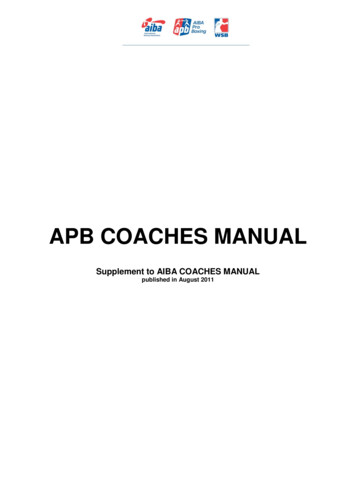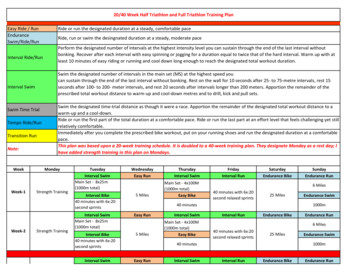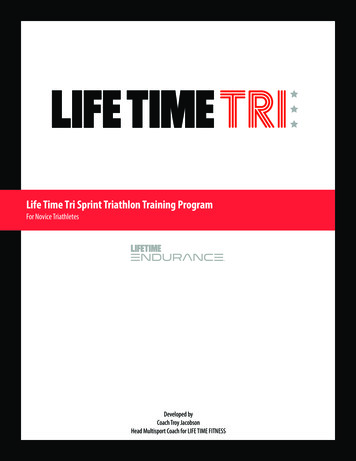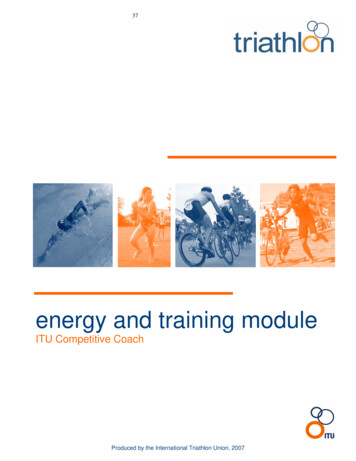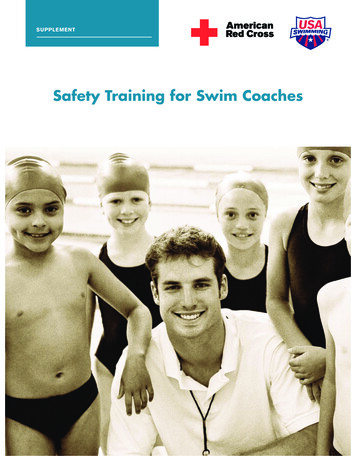
Transcription
SUPPLEMENTSafety Training for Swim Coaches
American Red CrossSafety Training for Swim CoachesCopyright 2008 by The American National Red Cross
iiAcknowledgmentsACKNOWLEDGMENTSThe Safety Training for Swim Coaches Supplement was developed through the dedication of both employees andvolunteers. Their commitment to excellence made this supplement possible.The following American NationalRed Cross and USA Swimming staffcontributed to the development ofthis supplement:Sue AndersonResource Development SpecialistUSA SwimmingTom AvischiousProgram and Services DirectorUSA SwimmingCharlene BoudreauPerformance Services ManagementDirectorUSA SwimmingMike EspinoProject Manager, Aquatics TechnicalDevelopmentAmerican Red CrossResearch and Product DevelopmentConnie HarveyManagerAmerican Red CrossResearch and Product DevelopmentMick NelsonClub Facilities Development DirectorUSA SwimmingLindsay Oaksmith, CHESSenior Associate, Aquatics TechnicalDevelopmentAmerican Red CrossResearch and Product DevelopmentDave ThomasSport Development ConsultantUSA SwimmingThe following individuals also provided guidance, support or review:Matthew BarnettHolme Roberts & Owen LLPGeorge BlockTechnical Vice PresidentUSA SwimmingTom DolanOlympic Gold Medalist 1996, 2000Barney FavaroFormer General CounselUSA SwimmingJohn LeonardExecutive DirectorAmerican Swimming CoachesAssociationAllan MeierHPER InstructorWestern Oklahoma State CollegeJohn PetersonPresident/CEORisk Management Services, Inc.Murray StephensHead CoachNorth Baltimore Aquatic ClubRichard YoungHolme Roberts & Owen LLPThe StayWell team for this editionincluded—Shannon BatesManaging EditorBryan ElrodSenior Developmental EditorStephanie WeidelSenior Production EditorPhotos on pages 2, 3, 9 (Fig. 2-2) and17 (Fig. 2-10) are courtesy of USASwimming
Table of ContentsTABLE OF CONTENTSIntroduction . . . . . . . . . . . . . . . . . . . . . . . . . . . . .ivChapter 3Emergency Planning and Response . . . . . . . . .21Chapter 1Water and Air Quality . . . . . . . . . . . . . . . . . . . . . . . .22Pool Chemicals . . . . . . . . . . . . . . . . . . . . . . . . . . . . . .23Responsible Coaching . . . . . . . . . . . . . . . . . . . . .1Electrical Safety . . . . . . . . . . . . . . . . . . . . . . . . . . . . .23Guidelines for Responsible Coaching . . . . . . . . . . . .2Weather and Environmental Conditions . . . . . . . . .23Professional Conduct and Legal Responsibilities . . .4Other Facility Safety Issuesand Recommendations . . . . . . . . . . . . . . . . . . . . .25Sexual Misconduct and Abuse . . . . . . . . . . . . . . . . . .4Minimizing Risk . . . . . . . . . . . . . . . . . . . . . . . . . . . . . .25Emergency Planning . . . . . . . . . . . . . . . . . . . . . . . . .26Chapter 2Distressed Swimmer and Drowning Situations . . .27How the Coach Can Assist . . . . . . . . . . . . . . . . . . . .28Safety Awareness in CompetitiveSwimming . . . . . . . . . . . . . . . . . . . . . . . . . . . . . . .7Training Plans and Athlete Fitness . . . . . . . . . . . . . . .8Swim Practice Safety . . . . . . . . . . . . . . . . . . . . . . . . .8Chapter 4Important Safety Considerations . . . . . . . . . . . . . . . .9Common Injuries and Medical Conditions . . .29Organizing Your Swim Practice . . . . . . . . . . . . . . . .10Head, Neck and Back Injury . . . . . . . . . . . . . . . . . . .30Hypoxic Training and Hyperventilation . . . . . . . . . .11Hypothermia . . . . . . . . . . . . . . . . . . . . . . . . . . . . . . . .30Turns . . . . . . . . . . . . . . . . . . . . . . . . . . . . . . . . . . . . . .11Heat-Related Emergencies . . . . . . . . . . . . . . . . . . . .30Head-First Entries and Racing Start Safety . . . . . . .12Medical Conditions in Swimmers . . . . . . . . . . . . . . .31Dryland Training . . . . . . . . . . . . . . . . . . . . . . . . . . . . .14Common Swimming-Related Injuries . . . . . . . . . . . .34Event Safety . . . . . . . . . . . . . . . . . . . . . . . . . . . . . . . .15Open Water Swimming Safety . . . . . . . . . . . . . . . . .17Glossary . . . . . . . . . . . . . . . . . . . . . . . . . . . . . . . 37References . . . . . . . . . . . . . . . . . . . . . . . . . . . . . 39iii
ivIntroductionINTRODUCTIONThis supplement along with the American Red Cross Swimming and Water Safety manual is required material for the American Red Cross Safety Training for Swim Coaches course. Successfulcompletion of the Safety Training for Swim Coaches course meets the water safety requirementof the USA Swimming Coaches Safety curriculum.The information in this supplement centers on possible life-threatening or hazardous situations inand around the water and the techniques and skills for preventing and dealing with them.For information on athlete development, training and workout design, visit the USA Swimmingand the American Swimming Coaches Association (ASCA) Web sites. Both of these organizationsprovide extensive educational resources and materials for coaches.This supplement includes workout and warm-up procedures, racing starts, event safety, emergency planning, electrical safety, weather and environmental conditions and handling of medicalconditions and injuries. The material presented in this supplement may be adapted to meet theindividual needs of each aquatic facility or swim club. Throughout this supplement there areInternet hyperlinks to publications, resources and sample forms for use by swim coaches. Whenviewing this supplement online, click on the hyperlink to access the information.Also, terms common to swimming are used throughout. The terms or phrases that may be unfamiliar to new coaches are set in bold face type and are underlined. When viewing this supplement online, scroll over the term or phrase to display the definition. These terms are also definedin the glossary.
Chapter 1Responsible Coaching
2American Red Cross Safety Training for Swim CoachesGUIDELINES FOR RESPONSIBLECOACHINGCoach Brown feels that she is a good judge of talent.Recently Jennifer, a 9-year-old swimmer, joined her program. Coach Brown was very excited to start coachingJennifer. After only a few weeks of practice, CoachBrown moved Jennifer into a training group composedmainly of 12 to 14 year olds who practice six days aweek. Jennifer did not seem very happy to leave herfriends and told her parents that swimming with the olderkids was not fun. Coach Brown continued to pushJennifer very hard and was very critical of any poor performances, demanding only the best from Jennifer. In ayear, Coach Brown began to enter 10-year-old Jenniferin Senior events. Now Jennifer is no longer winning all ofthe events she swims and often cries a lot after herraces. She has developed shoulder and back pain andcan barely complete a workout. After a few months,Jennifer’s parents tell Coach Brown that they are takingJennifer to a different club. Coach Brown is stunned andhurt. Has Coach Brown been a responsible coach forJennifer?In the scenario above, Coach Brown was so excitedabout Jennifer’s talent that she apparently lost sight ofthe fact that Jennifer was only 9 years old and juststarting out in swimming. She had Jennifer trainingwith much older swimmers and was critical and demanding. Jennifer’s physical ailments may have beencaused or aggravated by the rapid increase in trainingload.Responsible coaching is a major factor in preventinginjuries and providing a safe, enjoyable environment(Fig. 1-1). To provide a safe and enjoyable environment,you should follow these general guidelines:1. Remember what motivates athletes, particularly children, to play their sport. Their goal is seldom to win orFig. 1-1Fig. 1-2excel. Young athletes give the following as their primary reasons for being involved in athletics: Have fun and enjoy the excitement of competition Improve skills, face challenges and learn newskills Get exercise and stay in shape Enjoy teamwork (Fig. 1-2)2. Know the rules of the sport and insist that athletesalso know and follow them. Teach athletes to play fair.Conduct training and competition within the rules.3. Understand the basics of skill development and training methods appropriate for the level of the athletes.Learn and stay informed about coaching based on theprinciples of growth and development. USA Swimming’s “Successful Sport Parenting” CD-ROM has extensive material on athlete growth and development.4. Follow the safety guidelines of USA Swimming and itsLocal Swimming Committees (LSCs) or other nationalgoverning body, facility and individual club.5. Teach sportsmanship by example. Make sure swimmers feel good about doing their best, regardless ofwinning or losing. Never ridicule or shout at athletesfor making mistakes or losing.6. Balance constructive criticism with support and praise(Fig. 1-3).Fig. 1-3
Responsible Coaching7. Ensure that equipment and the facility are safe.8. Educate athletes about the dangers of nutritional andsubstance abuse.What exactly do these guidelines mean for a swimcoach in practical terms? Obviously there is more involved than designing swim sets and teaching strokework. Here are some of the things you must keep in mindon a day-to-day basis:1. Plan for swimmers’ long-term skills development. Allinstruction should be tailored to the needs, skills andabilities of the swimmers.2. Direct and supervise (Fig. 1-4). Ensure that swimmersare supervised by certified coaches—including yourself and other assisting coaches.3. Inspect the aquatic facility. Regularly check theswimming facility and equipment for deficiency orneed of repairs, document the findings in writingand report them to the facility management (seethe Sample Facility Safety Checklist in the USASwimming Safety/Loss Control Manual). Keep acopy of the report. Advise USA Swimming, or theapplicable national governing body, of any itemsreported to the facility that have not been corrected within a reasonable time frame.4. Warn of inherent risks. Notify swimmers and the parents of minors of risk factors, such as possible injuryin the sport. Swimmers can get injured!5. Be aware of swimmers’ medical conditions. Suggestpreseason medical examinations. Establish a procedure to be made aware of any preexisting or acutemedical conditions. A Medical History Questionnaireis helpful.6. Provide training and competitive opportunities. Ensure fair practice and swim meet experiences thatrelate to each athlete’s ability and experience.7. Know and understand emergency procedures. Beaware of the facility’s emergency action plans(EAPs) and be knowledgeable about appropriate firstaid and emergency response procedures. Coachesmust also know their roles in any EAP.8. Be a safety role model. Swimmers will adopt andmodel safe behaviors.Common Accident AreasAccording to USA Swimming accident reportstatistics, the most common areas where accidents occur during practice or meets are— In the water (over 40 percent) where swimmers may injure themselves during turns orfinishes, collisions with other swimmers orwhen entering or leaving the water. On the pool deck (over 20 percent) whereswimmers may slip on the deck surface ortrip over pool or training equipment. Other areas within the aquatic facility, suchas locker rooms, bleachers or hallways.Many accidents may be minimized or eliminated by the safety-trained swim coach who isalert and aware of potential hazards in andaround practice and swim meet areas. TheSafety Training for Swim Coaches Supplementprovides information for the swim coach to usein conducting an enjoyable, competitive andsafe swimming program.Fig. 1-43
4American Red Cross Safety Training for Swim Coaches9. Be able to say “no.” Coaches are sometimes so mo-tivated to see kids move, play and have fun that theyneglect potential hazards.10. Review safety procedures and rules. Review frequently with the athletes.PROFESSIONAL CONDUCT AND LEGALRESPONSIBILITIESCoach Smith works several jobs. He sometimes arrives atthe pool after his athletes are already there. He oftenfinds them playing around on the pool deck. Although hehas told them not to get in the water until he gets there,on hot days they are sometimes in the pool. He has toldthem to “start some dryland” until he arrives and heleaves the medicine balls, stretch cords and handweights unlocked so that the swimmers can get them out.The athletes range in age from 11 to 17. He has asked theolder athletes to teach and instruct the younger ones andexpects them to be responsible until he arrives. CoachSmith often brags about how reliable and responsible hisathletes are. He has told his coaching buddies that itdoes not matter if he arrives late because the swimmerscan take care of themselves. Is Coach Smith doing anything that may be considered negligent?Coaching is an honorable profession and many beginning coaches view coaching as a possible career choice.The desire to be treated as a professional carries the responsibility to act professionally at all times. There are legal responsibilities and duties that go well beyond teaching swimming strokes. A coach has a legal duty toprotect young people and safeguard their developmentwhen participating in sport. There is a growing trend toward formalized duties for coaches through written jobdescriptions and contracts. Once formalized, these dutiesmay be treated as legal responsibilities. Briefly stated,courts have determined that coaches are held to a standard of conduct expected of an ordinary reasonable person under like circumstances. Failure to meet that standard can be considered negligence. Negligence is thefailure to do what a reasonable and prudent personwould do in the same or similar circumstances or doingsomething that a reasonable and prudent person wouldnot have done. It is a coach’s responsibility to always actreasonably under the circumstances.In the scenario above, Coach Smith made several mistakes that a court likely would have considered negligent.Athletes should not be on the pool deck or in the pool unsupervised. They should not be doing dryland trainingwithout direct supervision of a coach. Older swimmersshould not be made responsible for supervising youngerswimmers.Legal duties for coaches have been established, onspecific facts, through various court cases. In specificcircumstances, courts have held these duties to include: Duty to properly instruct an athlete Duty to properly supervise an activity Duty to warn of inherent dangers in a sport Duty to provide a safe environment and equipment Duty to properly condition an athlete Duty to provide care in an emergency Duty to enforce rules and regulations Duty to fairly classify and group participants forcompetition according to skill level, age, experience, etc.In addition, there are best practices that can help prevent injury. These include— Reasonable planning to anticipate potentially dangerous circumstances and situations. As a professional,a coach should reasonably plan for all foreseeablehazards. Safety through organization and planning. Well-organized, planned activities and workouts are more likelyto be safe than chaotic, disorganized situations. Recordkeeping. All injuries and accidents should bereported as determined by the national governingbody. For example, USA Swimming requires that allaccidents be documented on Report of Occurrenceforms. Coaches should also keep records of safetyhazards that have been documented and reported.SEXUAL MISCONDUCT AND ABUSECoach Thomas, a young male coach, has a great groupof teenage female athletes. They joke around a lot witheach other and generally have a great time. CoachThomas sometimes tells slightly “off color” jokes to thegirls but they know it is all just in fun. At meets they hangout together, often in the coach’s room where they haveshaving parties. If one of the girls is upset about anything,she knows that she can always go to Coach Thomas. Often he drives a girl home from practice, takes her to getsomething to eat or has a girl come to his hotel roomwhen at meets so that they can talk privately. A coachingcolleague told Coach Thomas that some of the things hedoes with “his girls” may look inappropriate to an outsider, but Coach Thomas laughed it off. He said he shareseverything, including e-mails from the girls, with his wife.Do you see any reason for concern?Unfortunately, there have been occasional headlinesconcerning coaches accused of improper sexual conductwith athletes. Regardless of guilt or innocence, the accusation can ruin a career. Never put yourself in a situation
Responsible Coachingwhere there is even a hint of impropriety! Conduct yourself professionally at all times and remember that you arethe coach and your behavior is constantly being watchedand judged. Ignorance and immaturity are no defense! Donot put yourself in jeopardy.In the scenario, Coach Thomas is acting inappropriately. While most of the swimmers may laugh at his “offcolor” jokes, one may consider the behavior embarrassing or harassing. Additionally, inviting a girl individuallyinto his hotel room or having shaving parties in his roomis highly inappropriate. Taking a girl out to eat and drivingher home are additional behaviors that can be misinterpreted. Coach Thomas needs to clean up his jokes, stayaway from the shaving parties and have all of his meetings with individual swimmers in public rather than behind closed doors.The code of conduct in the USA Swimming Rules andRegulation book states that “any sexual contact or advance or other inappropriate sexually oriented behavioror action directed towards an athlete by a coach, official,trainer, or other person who, in the context of swimming,is in a position of authority over that athlete” is a violationof the code of conduct.Reporting Sexual AbuseState laws mandate that certain persons engaged in aprofessional capacity or activity who learn of facts thatgive reason to suspect that a child has suffered an incident of child abuse are legally obligated to report thesuspicion. Coaches may be included as such professionals required to report any suspected abuse. The failureof a coach to make a timely report of suspected abusemay result in criminal charges being brought against thecoach. Coaches should educate themselves regardingthe specific state laws applicable to them.There is a lot more to coaching than developing workouts and going to swim meets. Always keep the guidelines and legal responsibilities discussed in this chapterforemost in your mind. Avoid jeopardizing your athletesand yourself.5
Chapter 2Safety Awareness inCompetitive Swimming
8American Red Cross Safety Training for Swim CoachesTRAINING PLANS AND ATHLETEFITNESSCoach Roberts has decided that he wants his swimmersto train at a higher intensity level this season. He decidesto skip his normal introductory weeks spent on stroketechnique and low-intensity training and “get right towork.” His athletes had a brief break—they were onlyout of the water for two weeks. After warm-up on thefirst day, he announces a long training set that the swimmers had done midseason the previous year. The swimmers are slightly stunned, but he tells the swimmers hejust wants to see how they do. The workout concludeswith sprints and a session of dryland training. After a fewdays, many of the swimmers are reporting injuries, muscle soreness and pain. Coach Roberts thinks they justneed to “get tough.” Do you see anything wrong with histraining plan?As a coach, one of your major areas of responsibilityis to train athletes to get them ready for competition.Training methods, as well as the type, frequency, durationand intensity of workouts should vary among athletes depending on the athlete’s age, physical conditioning, mental state and goals. Judging athlete fitness and skill levelsare important determining factors when developing atraining plan. There was nothing wrong with CoachRoberts’ desire to increase the level of intensity for hisswimmers, but he cannot accomplish this on the first dayof practice. He needed to develop a plan to gradually increase the intensity during the season. The followingpoints can help guide you in developing a training plan: Teach correct technique. Focusing on correct technique helps prevent chronic and overuse injury. Incorporate drills and skill development that develop correct technique into your training plan. Both USASwimming and ASCA provide resources, such as publications and videos, to help coaches teach stroketechnique. Check with USA Swimming and ASCA onhow to obtain these materials. Incorporate warm-up and cool-down as structuredsegments of the workout. Require all swimmers to participate in a proper warm-up and cool-down. Balance fitness conditioning and skill development.For example, include both technique instruction andaerobic training. Increase training intensity, distances and training timegradually. A rule of thumb is to increase 10 percentweekly for inexperienced athletes or athletes returning from injury. Experienced swimmers can progressmore quickly. See the Season Plan Designer availableon the USA Swimming Web site. Instruct and supervise strength and dryland trainingappropriate to the level of the athlete. Encourage athletes to report injuries. Many athletesdo not want to say when they are injured. Create anatmosphere that encourages openness. Provide adequate rest and recovery.SWIM PRACTICE SAFETYCoach Peterson is preparing for a team practice. One ofher best 10-year-old swimmers excitedly introduces hiscousin to her. He asks if his cousin can practice with theteam. The young coach, in her haste to begin practice,tells the swimmer “yes” and turns her attention to layingout equipment in preparation for practice.The swimmer jumps into the pool and yells for hiscousin to follow him in the circle path of the warm-up.Not wanting to be shown up by his cousin, the boy hesitantly jumps into the 7-foot-deep pool. He begins tostruggle immediately because he cannot swim, muchless participate in a swimming practice. Coach Petersonstepped away from the pool to get some kickboards.While coming back from the supply room, she sees thestruggling boy near the pool edge, drops the kickboardsand rushes to the boy’s aid. She is able to reach out withher arm and grasp the victim to pull him to safety. Whatshould Coach Peterson have done differently to avoidthis situation?In the above scenario, Coach Peterson may haveplanned a great practice, but she ignored some basicsafety precautions. She allowed a swimmer into thepractice who was not a member. She knew nothingabout the child that she was allowing to join her practice session. She did not find out if he was a member ofthe applicable governing body, such as USA Swimming,or even if he knew how to swim. Also, she was busypreparing equipment rather than supervising and instructing the athletes. Fortunately, a tragedy wasavoided, but the visiting cousin never should have beenin the water.You are responsible for organizing training sessionsthat maximize the personal safety of each swimmer. Thiscan be a challenging task, especially when training largegroups in small pools or in only a few lanes. In addition,you should assume responsibility not only for the actualtraining session in the pool, but also for the periods immediately preceding and following each training session.Responsibility extends into the locker room as well asonto the pool deck. You should not leave athletes unattended. Supervisory responsibility varies with facility demands and needs, parental involvement and the transportation needs of the athletes. Be sure that you areaware of where your swimmers go when they leave thepool deck and the locker room.
Safety Awareness in Competitive SwimmingIMPORTANT SAFETY CONSIDERATIONSThe coach is responsible for ensuring that water andworkout activities are conducted safely. As in other aspects of coaching, remember that you are a role model.Your attitude and insistence on a safe workout environment translate into safety conscious swimmers. Nobodywants to see swimmers get hurt. You have a professionalstake in your athletes’ development. Remember that injury time is lost training time. That is a huge incentive toprovide a safe environment!Consider your planned workout and facility circumstances and work in collaboration with the facility management. Make sure there is always at least one individual present who is properly trained to handle emergencysituations. Some facilities require a lifeguard to be onsurveillance whenever swimmers are in the water, whileothers do not (Fig. 2-1). Be sure to follow facility rules andstate and local laws and regulations. In addition, followthese safety considerations: A certified coach must be on deck before any swimmers enter the water. A certified coach must remain on deck until all swimmers leave the pool deck. After all of the swimmersare out of the water, check the swimming area forpossible stragglers and then secure the area. Make sure that basic equipment, such as backstrokeflags or starting blocks, are in place at the facility(Fig. 2-2, 2-3). Make sure there are no unusual obstacles or hazards on the deck. Alert the facility staff ifanything unusual or dangerous is noticed and instructthe swimmers accordingly. Establish team policies governing each swimmer’s actions before, during and after each training sessionand meet. Ensure that athletes are supervised or safely exitingthe facility within a reasonable amount of time afterthe conclusion of the swim practice.Fig. 2-1Fig. 2-2Fig. 2-3 Ensure that swimmers understand the use of trainingequipment. Make swimmers aware of the potential foraccidents that may occur from use of equipment, suchas hand paddles, rubber tubing and kickboards. Prohibit swimmers from using the pool’s diving facilitiesduring the training session. Swimmers are not permittedto use diving facilities during swim practice. USA Swimming insurance does not cover the use of diving boardsor diving towers at any time under any circumstance. Choose swim practice water games carefully. Be sureto explain games thoroughly to the swimmers andidentify all risks. Supervise water games closely tomaintain order and minimize the potential for injury. Establish warm-up procedures to be followed at allpractices and meets. By using the same procedures atpractice, safe entry into the pool becomes a habit. Always enforce— A feet-first entry into the water. (Note: At swimmeet warm-ups, racing starts are only allowedwhen indicated by meet marshals and under themarshals’ supervision. At swim practice warm-ups,racing starts are only allowed when instructed andsupervised by a certified coach.) That swimmers look before entering the water. That starting blocks are used only under supervision. Circle swimming.9
10American Red Cross Safety Training for Swim CoachesORGANIZING YOUR SWIM PRACTICECoach Jones gets a call from her Age Group assistant saying that he will not be able to be at practice today. To makematters worse, when Coach Jones arrives at the pool, thepool manager apologetically tells her that, due to a scheduling error, she will not have use of all eight lanes tonight.Instead, she will have to consolidate her swimmers intofive lanes. Coach Jones normally has a Senior group of25 swimmers in five lanes, while the Age Group assistanthas another 20 swimmers in the other three lanes. NowCoach Jones will have 45 swimmers, both Age Group andSenior, in five lanes. Coach Jones has planned a long anddifficult freestyle set for her Senior Group tonight and is determined to stick to her workout plan. She decides to put afew of the Age Group swimmers in each lane and let themdo the Senior workout to “see how they do.” Is she creating an unsafe situation? What else could she have done?Facility circumstances may demand some flexibility onyour part. In the scenario above, Coach Jones was notflexible to the situation. She needed to readjust her workout plan due to the changed conditions. The youngerswimmers are at risk in crowded lanes with older swimmers. She could have grouped the swimmers by age andability in compatible lanes. She probably needed to adjusther workout plan for the Senior Group, or at the veryleast, devise a separate workout for the younger swimmers in their own lanes.Consider the following when you plan a swim practice: The number of swimmers Age and abilities of the swimmers Length of the pool (e.g., 50-meters or 25-yards) The number of lanes Lane width Water depth The level of direction and instruction needed byswimmersCircle Swimming GuidelinesCircle swimming during practice is the safest way formore than two people to swim in each lane. Teach andenforce safe circle swimming. The most common procedure is to have swimmers swim counterclockwise in alllanes—keeping to the right at all times (Fig. 2-4). In verynarrow lanes, alternating clockwise with counterclockwise lanes can reduce the incidence of swimmers hittingthe hands of swimmers in adjacent lanes.There is potential for accidents during circle swimming. Be wary of creating unsafe conditions by overloading the lane with too many swimmers. The width of a lanecan vary from swimming pool to swimming pool. The narrower the lane and the more swimmers in it, the greateris the risk of collision.Fig. 2-4The interval between swimmers and the number ofswimmers per lane are critical factors in establishingsmooth traffic in each lane. A typical interval betweenswimmers is 5 seconds. This allows each swimmer toclear the starting area before the next swimmer begins.This timeframe should provide swimmers with enoughopen water in front of and behind them to swim withoutinterference. An interval of more than 5 seconds may beeven safer as long as there is adequate lane space. Also,be aware of the number of swimmers in the lane and setintervals accordingly. Be sure that the first swimmer doesnot come around to turn before the last swimmer departsthe wall. An interval less than 5 seconds can create insufficient space between swimmers and con
COACHING Coach Brown feels that she is a good judge of talent. Recently Jennifer, a 9-year-old swimmer, joined her pro-gram. Coach Brown was very excited to start coaching Jennifer. After only a few weeks of practice, Coach Brown moved Jennifer into a training group composed m
